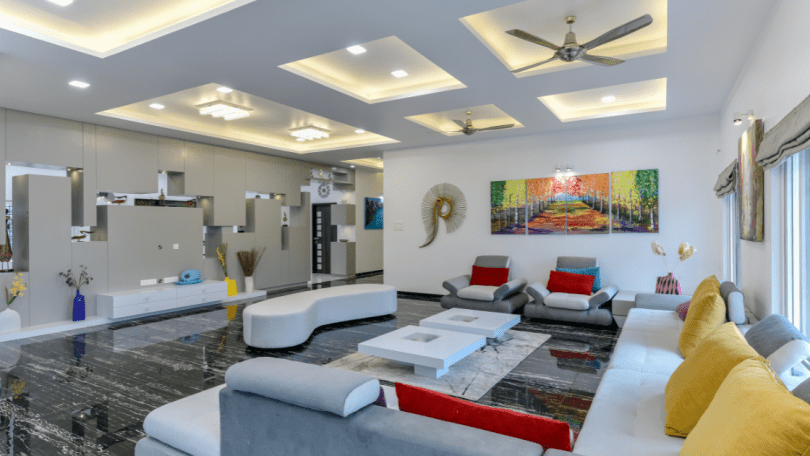Living rooms are the heart of our homes, yet many of us struggle to create functional, beautiful spaces that work for our daily lives. Whether you’re dealing with awkward corners, small apartments, or multipurpose spaces, finding the right furniture arrangement can feel like solving a complex puzzle with missing pieces.
A survey found that 90% of home buyers prioritize open floor plans where living rooms serve multiple purposes, highlighting the growing importance of adaptable living spaces.
The challenge intensifies when you consider how our needs change, from casual family movie nights to hosting dinner parties or accommodating overnight guests. Thankfully, there’s a solution that doesn’t require architectural renovation or constant furniture shopping: flexible furnishings designed to evolve with your needs.
Understanding Your Living Room’s Unique Puzzle Pieces
Before diving into furniture selections, you need to understand what makes your living space unique. Every room has its own character, challenges, and possibilities that directly impact which furniture arrangements will work best.
Start by identifying the permanent elements you’ll need to work around. Fireplaces, windows, built-in shelving, and doorways all create natural focal points that influence your layout. Measure these features and note how much wall space remains for couches for living room placement.
With the right flexible furniture, you can unlock a layout that balances function and flow, no matter the room size. Don’t forget to account for corners and angled walls. These architectural quirks often feel like obstacles, but with the right approach, they can become unique opportunities for creating interest in your space.
Analyzing Your Lifestyle Traffic Patterns
How you move through your space matters just as much as its physical features. Observe how family members naturally navigate the room, these are your traffic patterns.
Create a simple diagram marking doorways and identifying the most common paths people take. This visualization helps you avoid placing furniture in these natural walkways, preventing the frustration of constantly bumping into pieces or walking around obstacles.
Consider different zones based on activities: conversation areas, reading nooks, entertainment spaces. A well-designed living room accommodates multiple functions without feeling cluttered or confused.
Your living room should reflect how you actually live, not how you think a living room “should” look based on magazines or social media. This honest assessment forms the foundation for truly functional furniture arrangements.
The Transformative Power of Flexible Couches for Living Room Spaces
The right living room couches can completely transform how you use your space. Unlike traditional fixed-frame sofas, today’s flexible options offer unprecedented versatility.
Modular Sectionals: The Ultimate Layout Solution
Modular sectionals represent the pinnacle of flexible furniture innovation. These customizable pieces consist of individual components that can be arranged in countless configurations.
Need a large L-shape for movie night? Want to split it into separate seating areas for a party? Modular pieces make both possible with minimal effort. Some systems offer armless sections, corner units, and ottoman pieces that can be rearranged in minutes.
For smaller spaces, compact modular options provide the same flexibility without overwhelming the room. Look for pieces with built-in storage to maximize functionality in limited square footage.
Multi-Functional Sofa Designs
Beyond modular options, many modern sofas incorporate multiple functions in a single piece. Sleeper sofas have evolved dramatically, offering comfortable seating by day and genuinely restful sleep surfaces by night.
Adjustable-depth seating allows you to switch between upright, formal positions and relaxed, lounging configurations. Some models feature movable backrests or arm heights to accommodate different activities and preferences.
Consider sofas with integrated storage, charging stations, or convertible elements that adapt to your changing needs throughout the day. These intelligent designs eliminate the need for multiple furniture pieces, streamlining your living room layout.
Strategic Furniture Arrangement Principles for Challenging Spaces
Even with the most flexible furniture, certain arrangement principles can make or break your living room’s functionality. These strategies help overcome common layout challenges.
Corner Fireplace Solutions
Corner fireplaces often create awkward angles that complicate furniture arrangement. Instead of fighting against this diagonal element, use it to create dynamic layouts.
Position your primary seating at a complementary angle to the fireplace, creating a conversation area that celebrates rather than ignores this architectural feature. Swivel chairs prove invaluable here, allowing guests to turn toward the fire or toward the conversation.
Consider floating your furniture away from walls to create a more intimate seating arrangement that’s oriented toward both the fireplace and other features like windows or entertainment centers.
Open Concept Layout Strategies
Open layouts present unique challenges, as your living room layout must harmonize with adjacent spaces while maintaining distinct functionality. Use area rugs to define boundaries without walls.
Place flexible furniture pieces like movable ottomans or lightweight chairs at transition zones, allowing them to serve either the living area or adjacent spaces as needed. Modular sectionals can be configured to visually separate spaces while maintaining an open feel.
Pay attention to the backs of furniture pieces visible from other areas, choose attractive finishes or consider console tables behind sofas to create more polished transitions between spaces.
Small Space Furniture Innovations That Maximize Function
Limited square footage demands creative solutions, but small space furniture has never been more innovative or stylish.
Double-Duty Pieces That Save Space
Every piece in a small living room should serve multiple functions. Coffee tables with lift-tops transform into work surfaces or dining tables. Storage ottomans provide seating, surface space, and hidden storage for blankets or games.
Look for nesting tables that can expand when needed for entertaining but tuck away compactly when not in use. Wall-mounted shelving eliminates floor space requirements while providing essential storage.
Flexible furniture like folding or stacking chairs allow you to accommodate occasional guests without cluttering your daily living space with rarely-used seating.
Optical Illusions for Spaciousness
Strategic furniture selection creates the illusion of more space. Choose sofas and chairs with exposed legs rather than skirted pieces, this visibility of floor area makes rooms feel larger.
Consider transparent elements like glass tabletops or lucite chairs that don’t visually interrupt your space. Mirrors strategically placed to reflect light and views expand perceived dimensions.
Scale matters tremendously in small spaces, appropriately sized pieces create balance, while oversized furniture makes rooms feel cramped regardless of arrangement.
Adaptable Living Room Layouts for Changing Needs
Today’s homes must accommodate a variety of activities, often shifting multiple times throughout a single day. Your living room layout should be equally adaptable.
Entertainment-Ready Transformations
Design your primary layout with everyday comfort in mind, but incorporate elements that can quickly transition for entertaining. Consider how your space flows when hosting different numbers of guests.
Flexible furniture arrangements might include ottomans that normally serve as coffee tables but can be repositioned as extra seating. Nesting side tables can be distributed throughout the room when serving snacks or drinks.
Think about sight lines to screens or conversation areas, creating configurations that work equally well for intimate gatherings or larger parties.
Creating Your Perfect Living Room Solution
The perfect living room isn’t about following rigid rules or trends, it’s about creating a space that adapts to your unique needs while maintaining visual harmony. Flexible furniture provides the foundation for this adaptability, allowing your space to evolve as your life does.
Remember that the most successful layouts often develop through experimentation. Don’t be afraid to move pieces around, try unexpected angles, or combine different furniture types to discover what works best for your specific situation. The best living room layout is one that feels both comfortable and inspiring, a space where furniture serves your lifestyle rather than dictating it.
By embracing flexibility in both your furniture choices and your arrangement approach, you transform the puzzle of living room design from a frustrating challenge into an opportunity for creative expression.
Common Questions About Living Room Layouts
What is the 2/3 rule for living rooms?
The 2/3 rule helps balance your furniture with your available space. Your main furniture piece should occupy roughly two-thirds of the wall it sits against, leaving breathing room on either side so the piece neither overwhelms nor looks undersized in the space.
What are the four rules in furniture arrangement?
Effective furniture arrangement considers the room’s purpose, establishes a clear focal point, creates visual balance through symmetry or thoughtful asymmetry, and maintains proper scale and proportion between pieces and the overall space.
What is the biggest mistake in furniture placement?
The most common mistake is pushing all furniture against walls, creating an awkward “waiting room” effect. Other errors include blocking natural traffic paths, ignoring proper scale, placing seating too far apart for conversation, and failing to consider door swings and clearances.





